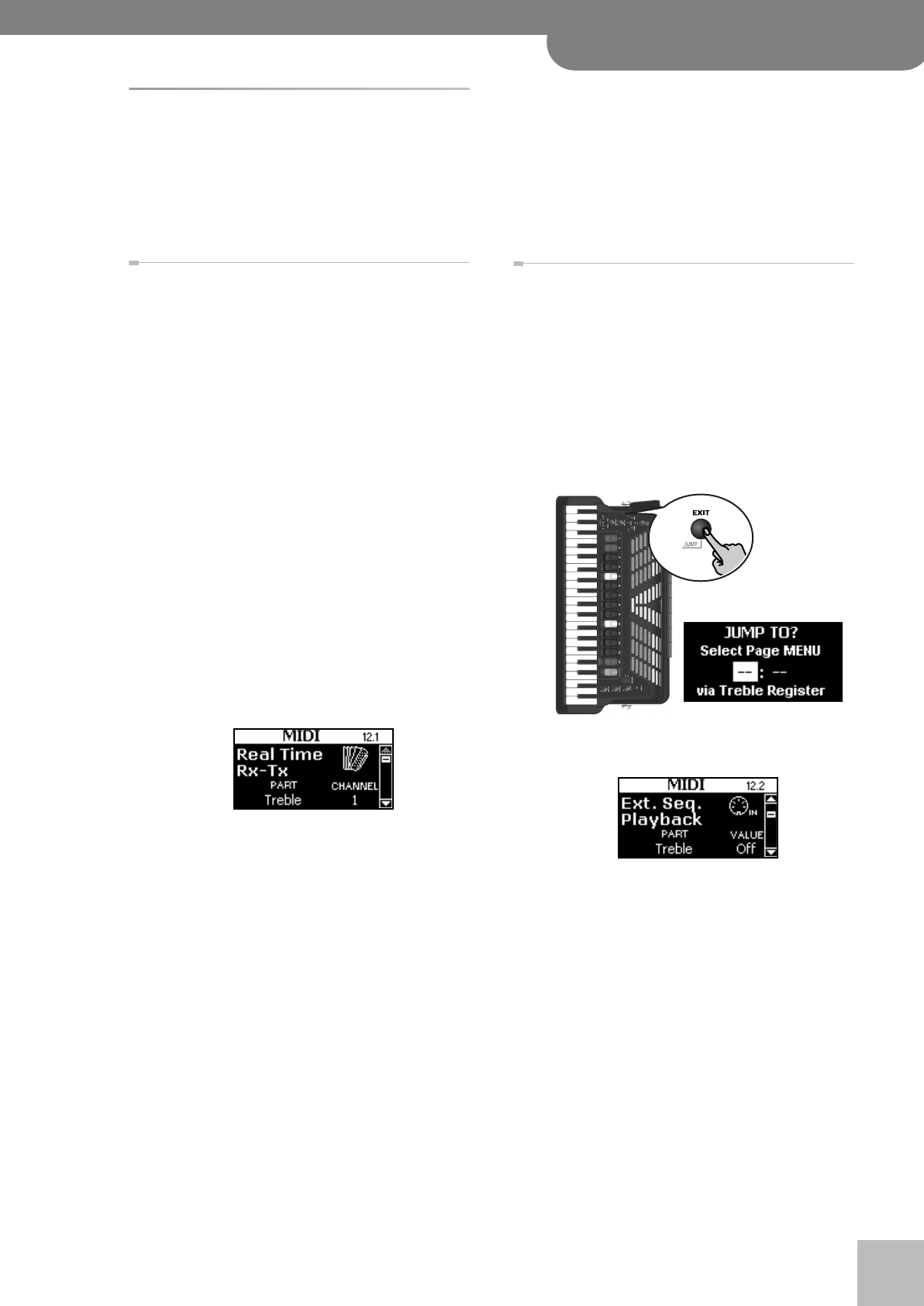
Global MIDI parameters (Advanced)
V-Accordion
r
109
Global MIDI parameters
The parameters discussed here are part of a separate
mode (called “MIDI”). Their settings, however, are saved
to the FR-7x’s Global memory (there is no separate MIDI
memory). Let us first look at the parameters that apply
to all Sets. See page 113 for the parameters that can be
set for each section individually and saved to a Set.
MIDI channel numbers
(12.1 RealTime RX-TX)
The table on page 108 specifies the default MIDI chan-
nel assignments the FR-7x uses. Those choices are based
on how most accordion players prefer to use their
instrument. You can, however, change the MIDI channel
assignments.
Bear in mind that the channel assignments set here
apply both to the transmission (“TX”) and reception
(“RX”) of MIDI data.
And finally: in DUAL, HIGH and LOW modes (page 30),
the treble keyboard transmits on two channels simulta-
neously – the TREBLE and ORCHESTRA channels. As
stated earlier, the chord buttons of the Bass keyboard
use a separate MIDI channel.
(1) Return to the main page.
(2) Press and hold the [EXIT÷JUMP] button until the
display shows the “JUMP TO” page.
(3) Press register [12] to specify the function group.
The MIDI channels can be set via a parameter of the
“MIDI” group, which is why you need to select that
group.
(4) Press register [1] to select the following page:
(5) Press the [DATA÷ENTER] knob to select “PART” (left
entry), then turn it to select the part whose MIDI
channel you want to set.
The entries you can select are: “Treble”, “Bass/Free”,
“Chord”, “Orc Bass”, “Orchestra”, “Orc Chord”, “Orc
Free Bs”, “Basic Ch”, and “Control Ch”.
The “Basic Ch” (default setting “13”) can be used for
selecting Sets from an external MIDI device (using
program change numbers 1~80). If your external
source sends Bank Select messages along with the
program change number, CC00 and CC32 must both
be set to “0”.
The “Control Ch” (default setting “13”) can only be
used for sending program change messages (see
below).
(6) Press the [DATA÷ENTER] knob to select “CHANNEL”
(right entry), then turn it to select a MIDI channel.
The options are: 1~16 and “Off”. Select “Off” if the
part in question should neither receive nor transmit
MIDI data.
(7) Press the [DATA÷ENTER] knob to confirm your
selection.
Note: Though it is perfectly possible to assign the same
MIDI channel to several sections, the result is usually disap-
pointing and may lead to a lot of confusion.
(8) If necessary, repeat steps (5)~(7) to assign different
MIDI channels to the remaining parts.
(9) See page 103 for how to save your changes.
Preventing sections from sending MIDI data
(12.2 Ext. Seq. Playback)
By selecting “On” for a section, you switch off its con-
nection with the internal tone generator (this is what
MIDI buffs call “Local Off”). The section now receives
MIDI data from a sequencer or other instrument you
connect to the FBC-7’s MIDI IN port. (It also transmits
MIDI messages to the FBC-7’s MIDI OUT port.)
(1) While the main page is displayed, press and hold
the [EXIT÷JUMP] button until the display looks as
follows:
(2) Press register [12] to specify the function group.
(3) Press register [2] to select the following page:
(4) Press the [DATA÷ENTER] knob to select “PART” (left
entry), then turn it to select the part whose setting
you want to change.
The parts you can select here are: “Treble”,
“Bass&Chord”, “Orchestra”, and ALL”. Select “ALL” to
change the status of all available sections.
Note: The “Bass&Chord” entry also includes the Free Bass,
Orchestra Bass, Orchestra Chord and Orchestra Free Bass
sections.
(5) Press the [DATA÷ENTER] knob again to select
“VALUE” (right entry), then turn it to select “On”
(disconnect the part from the internal tone gener-
ator) or “Off” (normal operation).
FR-7x GB.book Page 109 Tuesday, August 25, 2009 10:58 AM


















